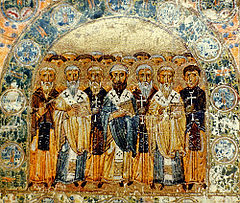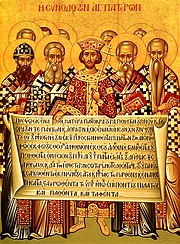Great Church
"[7] Lawrence S. Cunningham, and separately, Kugel and Greer state that Irenaeus's statement in Against Heresies Chapter X 1–2 (written c. 180 AD) is the first recorded reference to the existence of a "Church" with a core set of shared beliefs as opposed to the ideas of dissident groups.
... For the churches which have been planted in Germany do not believe or hand down anything different, nor do those in Spain, nor those in Gaul, nor those in the East, nor those in Egypt, nor those in Libya, nor those which have been established in the central regions of the world.
But as the son, that creature of God, is one and the same throughout the whole world, so also the preaching of the truth shineth everywhere, and enlightens all men that are willing to come to a knowledge of the truth.Cunningham states that two points in Irenaeus' writing deserve attention.
[8] At the beginning of the 3rd century the Great Church that Irenaeus and Celsus had referred to had spread across a significant portion of the world, with most of its members living in cities (see early centers of Christianity).
[12][13] In the 4th century, as Saint Augustine commented on Psalm XXII, he interpreted the term to mean the whole world, writing: "The great Church, Brethren, what is it?
[14] The epoch of the Great Church witnessed the development of key theological concepts which now form the fabric of the religious beliefs of the large majority of Christians.
[1] Relying on Scripture, prevailing mysticism and popular piety, Irenaeus formalized some of the attributes of God, writing in Against Heresies Book IV, Chapter 19: "His greatness lacks nothing, but contains all things.
[28] Roger E. Olson (1999) uses the term to refer to the Great Church at the time of the Council of Chalcedon (451) when the Patriarch of Constantinople and Bishop of Rome were in fellowship with each other.


